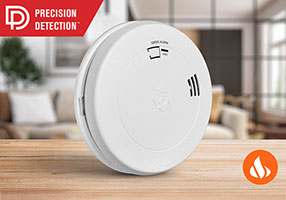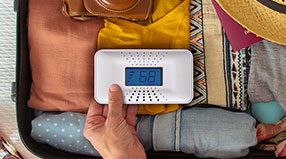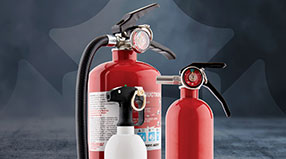Battery Operated Carbon Monoxide Detectors
Common Questions About First Alert Battery Operated Carbon Monoxide Alarms
Why should I be worried about carbon monoxide?
Carbon monoxide (CO) is an invisible, odorless, tasteless gas produced when fossil fuels do not burn completely or are exposed to heat. These fuels include wood, coal, charcoal, oil, natural gas, gasoline, kerosene, and propane. Common household appliances are often sources for releasing carbon monoxide. If these appliances are not properly maintained, are improperly ventilated, or malfunction, they are capable of raising CO levels quickly. The presence of carbon monoxide is a real danger now that homes are more energy efficient. Airtight homes with added insulation, sealed windows, and other weatherproofing can sometimes trap CO inside. The installation of fully functioning carbon monoxide alarms remains the best way to protect your home.
Where should I install carbon monoxide alarms?
The NPFA (National Fire Protection Association) is recommending that homeowners install carbon monoxide detectors on every level of their home. You’ll want to focus on bedrooms and rooms connected to areas where people usually sleep. Another area of focus would be near attached garages in the event a car is left running. You’ll generally want to avoid installing carbon monoxide detectors too close to any fuel burning appliances (at least 15 ft. away). You’ll also want to avoid high humidity areas such as bathrooms with showers. Installing a carbon monoxide alarm in direct sunlight or in an area with high air circulation (near a heating or ac vent) should also be considered off limits.
How high off the floor should I install a carbon monoxide alarm?
Carbon monoxide is slightly lighter than air and it diffuses throughout the home evenly when released. For this reason, the installation height of a co detector will not influence the alarm’s ability to detect carbon monoxide. This means you do not need to install co alarms near the floor or high up on a wall. When you decide to install a carbon monoxide alarm, you should select a location that will allow your detectors to stay clean while being easily reached for inspection. You should also consider an area that will keep the co alarm away from interference such as children, pets and anything else that could potentially tamper with the alarm.
How do I prevent my carbon monoxide detector from triggering false alarms?
When working as intended, a carbon monoxide detector shouldn’t be triggering false alarms. As such, an activated alarm should be taken seriously. Remember, carbon monoxide is invisible, odorless and extremely dangerous. That being said, there are a few instances that can trigger a false alarm. It mostly has to do with the location of the co alarm. If a carbon monoxide alarm is located within 15 to 20 ft. from any fossil fuel burning source such as a furnace, this could be the cause. The same can be said for installation within 10 ft. from a high humidity source such a shower. Be sure to check that fossil fuel burning appliances are burning fuel completely. Check pilot lights/flames for blue color. The appearance of yellow or orange flames indicates incomplete combustion which is a source of carbon monoxide. Correct these issues and your co alarm should be functioning properly.
What do the different beep patterns for my carbon monoxide alarm mean?
First Alert Carbon Monoxide Detectors have different beep patterns to communicate whether there is an emergency or simply a need to replace the unit. It is important to know the difference between the beeps.
- 4 beeps and a pause: This means that there is carbon monoxide in the air. You should seek fresh air immediately and call 911.
- 1 beep every minute: This means that the alarm has low battery power and needs a replacement.
- 3 beeps every minute: This means the alarm has encountered a malfunction and needs replacement.
- 5 beeps every minute: This means your alarm has reached the end of its life and needs to be replaced with a new detector.
Why should I choose a battery operated carbon monoxide alarm?
Battery operated carbon monoxide alarms provide tremendous flexibility as they can immediately be setup and installed without a wired connection. First Alert Battery Operated Carbon Monoxide Detectors use advanced electrochemical CO sensors (the most accurate CO sensor available) to detect the presence of elevated carbon monoxide levels. When carbon monoxide in the surrounding area is identified, your First Alert Battery Operated CO Detector will sound off, giving you an opportunity to escape safely.
First Alert Battery Operated Carbon Monoxide Detectors
The First Alert Store features basic battery operated carbon monoxide alarms that allow for swift activation and lasting protection. First Alert Battery Operated Combination Smoke and Carbon Monoxide Alarms are also available and provide dual protection from smoke and co. First Alert Wireless Interconnect Battery Operated Carbon Monoxide Detectors will allow you to link up a series of detectors to one another to create your very own smoke, fire and co protection system.



